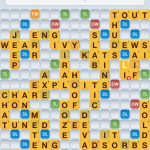In case you didn’t know, FiveThirtyEight is an awesome blog about statistics. Recently, they posted a challenge against the new Words With Friends Artificial Intelligence. For the sake of science, I decided to replicate their study.
I’m an avid WWF player. As of this writing, I have played exactly 1800 games since October 2010 (which amounts to a little over one game per day). Of those, I’ve won 930, lost 864, and tied 6. Yes, I win more than I lose, but not this isn’t statistically significant (χ² = 2.4281, df = 1, p-value = 0.1192). In other words, I win more than I lose mostly due to chance.

